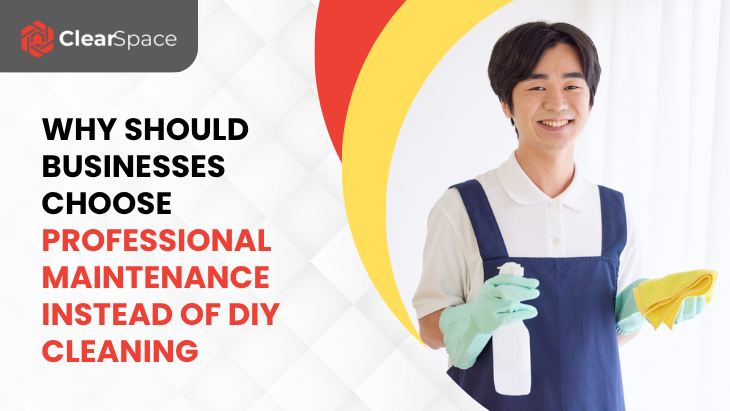In the fast-paced world of modern business, where profit margins, deadlines, and efficiency dominate decision-making, maintenance often slips down the list of priorities. Whether it involves building upkeep, equipment servicing, IT systems, or routine cleaning, maintenance is frequently viewed as a background task—something that can be delayed when budgets tighten or when time is short. Unfortunately, this mindset comes with significant risks. Trusted Cleaning & Device Repair Services Neglecting maintenance may appear to save money in the short term, but the long-term consequences are far more damaging.
Letting maintenance slide exposes a business to a wide range of risks—financial, operational, safety-related, and reputational. Small, unnoticed issues can quickly escalate into large-scale problems that disrupt operations, compromise safety, and incur unexpected costs. The question, therefore, is not whether maintenance should be done, but how much risk a business is willing to accept by ignoring it. The truth is simple: every time maintenance is postponed, the potential for damage increases exponentially.
The True Definition and Value of Maintenance
Maintenance is not merely the act of fixing something that is broken. It is a preventive strategy designed to keep systems, infrastructure, and equipment running efficiently and safely. From HVAC systems and electrical networks to machinery and office interiors, regular maintenance ensures that all assets perform optimally throughout their lifespan.
Effective maintenance also supports compliance with health and safety regulations, reduces downtime, and enhances the overall value of assets. It helps businesses predict and prevent problems before they occur, turning potential emergencies into manageable tasks. When companies understand maintenance as an investment rather than an expense, they not only protect their operations but also gain a competitive edge.
However, when maintenance is ignored or delayed, these benefits vanish. Instead, organizations face rising repair costs, shorter equipment lifespans, and increased operational hazards. In this way, neglecting maintenance does not save money—it shifts costs into the future, where they often multiply.
Financial Risks: The Illusion of Saving Money
The most immediate risk of skipping maintenance is financial. Many organizations reduce maintenance budgets in the belief that it will help save money in the short term. In reality, deferred maintenance is like a ticking time bomb—minor wear and tear may go unnoticed for months, but once it escalates into failure, the repair costs can be exponentially higher.
For instance, ignoring a small leak in a roof can lead to extensive water damage, mold growth, and structural repairs that cost thousands. Similarly, skipping regular HVAC servicing can cause the system to fail during extreme weather, forcing expensive emergency repairs or replacements. Machinery that is not lubricated or inspected regularly may suffer from breakdowns that halt production entirely, leading to lost revenue.
These unplanned expenses often far exceed the cost of preventive maintenance. According to facility management studies, every dollar spent on preventive maintenance can save up to five dollars in future repair or replacement costs. Thus, what appears to be a budget cut often turns into a financial burden, reducing profitability and straining cash flow.
Operational Risks: Downtime and Productivity Loss
When maintenance is neglected, the efficiency of daily operations declines. Machines start to malfunction, systems become unreliable, and downtime increases. Even minor disruptions—such as a malfunctioning printer or a broken elevator—can slow workflow and frustrate employees. In industries such as manufacturing, logistics, or healthcare, where operations depend on precision and reliability, downtime can have catastrophic effects.
Unexpected equipment failures can halt production lines, delay deliveries, and damage customer relationships. Businesses that operate in competitive markets risk losing clients when they cannot meet deadlines due to preventable malfunctions. Moreover, the lack of predictability caused by deferred maintenance makes it difficult to plan operations efficiently, leading to inefficiencies across departments.
Professional maintenance ensures consistency. Regular inspections and timely servicing reduce the likelihood of sudden breakdowns, keeping workflows smooth and reliable. In contrast, ignoring maintenance introduces uncertainty—a silent risk that grows with every delay.
Safety and Health Risks: Protecting People Comes First
Perhaps the most serious consequence of letting maintenance slide is the threat it poses to safety. Faulty wiring, poorly maintained machinery, broken fixtures, or slippery floors can all lead to workplace accidents. When safety hazards go unaddressed, the risk of injury or even fatality increases dramatically.
Beyond physical harm, neglecting maintenance can affect indoor air quality, temperature control, and sanitation, which in turn impact employee health and comfort. For example, failure to maintain HVAC systems can cause poor ventilation, leading to respiratory issues or the spread of airborne illnesses. Similarly, neglecting plumbing maintenance may cause water contamination or leaks that promote mold growth.
Employers have both a legal and ethical responsibility to ensure a safe working environment. Occupational safety regulations require that equipment and facilities be kept in good condition. Non-compliance can lead to lawsuits, fines, and damaged reputation. Ultimately, safety lapses caused by poor maintenance are preventable tragedies that no responsible business should risk.
Reputational Risks: The Image of Neglect
Reputation is one of the most valuable assets a business can have—and one of the easiest to lose. A poorly maintained facility communicates neglect, lack of professionalism, and carelessness. Whether it’s a customer visiting an office with flickering lights and stained carpets or a client noticing unreliable machinery during a plant tour, the impression is the same: the company does not care about quality.
For customer-facing businesses such as hotels, restaurants, and retail stores, poor maintenance directly affects the customer experience. Dirty restrooms, broken fixtures, or unkempt surroundings can lead to negative reviews and loss of repeat business. Even in industries with minimal client interaction, employee perception matters. Workers who see their company ignoring maintenance issues may feel undervalued, reducing morale and productivity.
In contrast, a well-maintained environment reflects pride, competence, and reliability. It shows that the organization values quality and attention to detail. The risk of losing reputation due to neglect is far greater than the cost of routine maintenance.
Compliance and Legal Risks: The Price of Neglect
Many industries operate under strict safety, environmental, and operational regulations. These rules require that facilities and equipment be maintained regularly to meet compliance standards. When maintenance is delayed or ignored, a company may unknowingly violate these regulations, leading to penalties or legal action.
For instance, a malfunctioning fire alarm system, nonfunctional emergency exits, or unsafe electrical wiring can all constitute violations of safety codes. Similarly, neglecting air filtration or waste management systems may breach environmental laws. In such cases, companies not only face financial penalties but also public scrutiny and loss of operating licenses.
Regular maintenance ensures that businesses stay compliant with these regulations. Maintenance logs, inspection reports, and certifications serve as documentation of compliance, protecting companies from liability and demonstrating due diligence to authorities. Ignoring these responsibilities, on the other hand, exposes businesses to costly lawsuits and regulatory sanctions.
Employee Productivity and Morale: The Psychological Impact of Neglect
A clean, well-maintained workplace boosts morale, productivity, and overall employee satisfaction. When employees work in a space that is organized, functional, and safe, they feel valued and motivated. On the other hand, constant maintenance issues—such as broken lights, malfunctioning equipment, or dirty environments—can cause frustration, stress, and disengagement.
When workers spend time dealing with maintenance problems or adjusting to inefficient systems, their focus and output decrease. Furthermore, visible signs of neglect can create a sense of instability, making employees question the organization’s financial health or management competence. Over time, this may lead to higher turnover rates and reduced loyalty.
Investing in regular maintenance demonstrates that a business cares about the working conditions of its employees. It cultivates pride in the workplace and fosters a culture of responsibility and attention to detail—qualities that directly influence productivity and long-term success.
Environmental Risks: The Sustainability Factor
In the era of sustainability and corporate social responsibility, neglecting maintenance can also lead to environmental harm. Leaky plumbing, inefficient HVAC systems, or outdated machinery waste energy and water, increasing the company’s carbon footprint. In addition, poorly maintained waste management systems may result in improper disposal practices that harm the environment.
Regular maintenance supports sustainability goals by ensuring that equipment operates efficiently, minimizing waste and energy consumption. Businesses that prioritize maintenance are often better positioned to meet green certifications or environmental compliance standards. Conversely, those that neglect maintenance risk damaging their reputation as responsible corporate citizens and may even face environmental penalties.
The Domino Effect: How Small Neglect Becomes Big Problems
One of the most dangerous aspects of deferred maintenance is its cumulative nature. A small issue that could be fixed in minutes today can escalate into a system-wide problem tomorrow. For instance, a loose bolt in machinery might cause vibrations that damage multiple components. A clogged filter might reduce efficiency until the entire system overheats and fails.
This “domino effect” of neglect often goes unnoticed until it reaches a critical point. By then, the damage is extensive and expensive to repair. Businesses that rely on reactive maintenance—fixing problems only after they occur spend significantly more over time than those that follow preventive or predictive maintenance schedules. In short, every skipped inspection or delayed repair increases the probability of a major breakdown.
Building a Culture of Preventive Maintenance
The key to minimizing risk lies in adopting a proactive maintenance culture. This means treating maintenance as a continuous and strategic process, not a sporadic chore. Preventive maintenance schedules, regular inspections, and employee training all contribute to reducing risks and ensuring long-term asset reliability.
Technology can also play a crucial role. Modern maintenance management systems can track performance data, schedule inspections automatically, and predict failures using analytics. These tools allow businesses to act before problems occur, saving time, money, and stress.
Creating a culture where maintenance is valued encourages accountability and foresight. It ensures that every part of the organization—from management to maintenance staff—understands the importance of upkeep in achieving business success.
Conclusion
Letting maintenance slide is one of the most dangerous gambles a business can take. ClearSpace What begins as a small delay in cleaning, inspection, or servicing can spiral into financial losses, operational breakdowns, safety hazards, and reputational damage. The true risk lies not only in what breaks but also in what those failures represent neglect, unpreparedness, and lack of foresight.
Professional maintenance, by contrast, protects assets, enhances efficiency, and ensures compliance and safety. It saves money in the long term, fosters employee morale, and strengthens a company’s reputation. In a competitive market, where reliability and quality define success, consistent maintenance is not optional—it is essential.
Ultimately, the question is not whether you can afford to maintain your facilities and equipment, but whether you can afford the risks of not doing so. In nearly every case, the cost of neglect far outweighs the investment in proper maintenance. Choosing to maintain is choosing stability, safety, and sustainability—the foundations of lasting business success.





Leave a reply